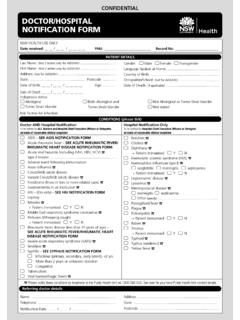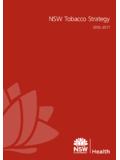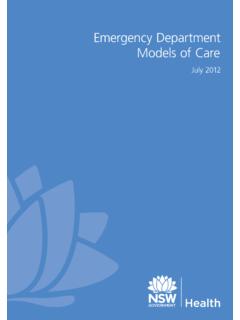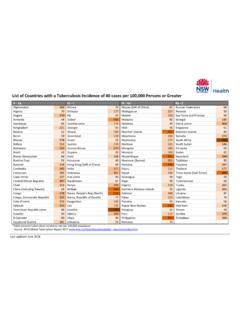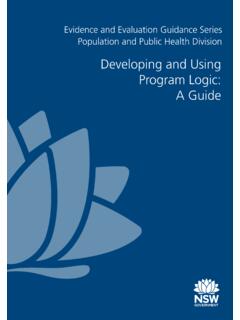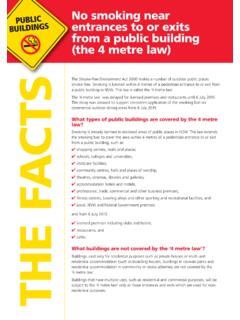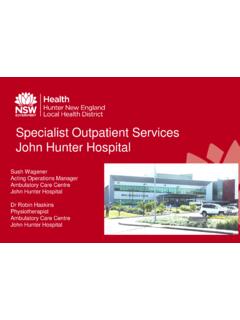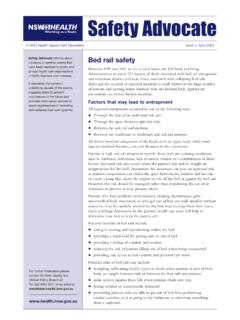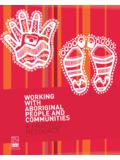Transcription of Communicating positively - NSW Health
1 Communicating positively A guide to appropriate aboriginal terminology The painting See when were talking right were walking in the right direction The painting displays a centerpiece in the shape of an eye with the figures of people sitting around the inside. The dot work trailing from the mouths of the figures and blending into the circle of the eye is a representation of using the correct terminology. Throughout the background there are lines of cross hatching which generally represent ownership or ownership of land. In this painting it is used as a symbol that we as people have ownership over our bodies and minds and therefore have a choice in the style of language that we use. The footprints are seen heading in the one direction heading along the same dot work speech lines, to represent that once we have learnt the correct protocols and terminology we can utilize this and progress as a nation towards a brighter future.
2 The green circles which fade from dark to light in the center are representations of eradicating bad terminology and inappropriate use of dialogue, so that eventually through education of correct procedures these non-accepted ways will deteriorate. By Kylie Cassidy Central Coast aboriginal Artist NSW DEPARTMENT OF Health . 73 Miller Street North Sydney NSW 2060. Tel. (02) 9391 9000. Fax. (02) 9391 9101. This work is copyright. It may be reproduced in whole or in part for study training purposes subject to the inclusion of an acknowledgement of the source. It may not be reproduced for commercial usage or sale. Reproduction for purposes other than those indicated above, requires written permission from the NSW Department of Health . NSW Department of Health 2004. SHPN (AHB) 030102. ISBN 0 7347 3542 1. For further copies of this document please contact: Better Health Centre Publications Warehouse Locked Mail Bag 5003.
3 Gladesville NSW 2111. Tel. (02) 9816 0452. Fax. (02) 9816 0492. Further copies of this document can be downloaded from the NSW Health website: May 2004. Contents Introduction ..2. Terminology guide ..4. Collective names used to describe aboriginal and Torres Strait Islander people ..9. Terms associated with aboriginal communities and community organisations ..14. Other terms ..21. Terms not to be used ..29. Additional resources ..31. 1. Introduction Purpose The purpose of this guide is to provide NSW Health staff with background information and guidance on appropriate word usage when working with aboriginal people and communities, and when developing policy and programs to improve Health outcomes for aboriginal people. The use of accurate and non-offensive language is an essential component of aboriginal cultural respect and communication training.
4 In developing this guide, the aboriginal Health Branch (AHB) has worked closely with aboriginal staff within the NSW Department of Health and Area Managers of aboriginal Health (AMAHs) within Area Health Services (AHSs), as well as the aboriginal Health and Medical Research Council of NSW (AH&MRC), the peak body representing aboriginal Community Controlled Health Services (ACCHSs) in NSW. Scope This guide relates to aboriginal people in NSW and gives the recommended word usage for NSW Health employees. The authors of this guide have aimed to use current names and terminology selected by aboriginal people themselves. Usage of some terminology may vary with location. If you are unsure about using a particular term, ask the local aboriginal community/ies or ACCHSs to identify their preferred terms. Alternatively, contact the AMAH in your AHS, the AH&MRC, the local aboriginal land council (LALC), or the AHB for further guidance.
5 Note that this guide does not list the many and varied names of individual aboriginal language groups. Before European colonisation, at least 70 aboriginal languages and dialects were spoken in the area now known as For further information about the names of these varied language groups, refer to Horton (1994).2. 2. Introduction Structure An overview section outlining key aspects of aboriginal history is provided on pages 6-7. The Terminology Guide starts on page 9 and lists a number of commonly used terms under four major categories: Collective names used to describe aboriginal and Torres Strait Islander people Terms associated with aboriginal communities and community organisations Other terms Terms not to be used. A description of each term, as well as its recommended usage and issues for consideration, is provided in the remaining part of the document (pages 9-30).
6 Additional reading and useful websites are listed on page 31. The importance of non-discriminatory and accurate language Following European colonisation, aboriginal people were forbidden from speaking traditional languages and aboriginal languages suffered enormous erosion as a English was used to describe and communicate with aboriginal people and led to the use of inappropriate and often discriminatory language. Generally, language can be seen as a direct reflection of the particular culture and beliefs that have given rise to it. For example, the English language is not capable of embodying the cultural imperatives, values and contexts associated with aboriginal languages. Because the European colonists did not understand and were generally prejudiced against aboriginal ways of life, the language they used to address and describe aboriginal people was often discriminatory and offensive.
7 Today, just as attitudes towards aboriginal culture are changing, terms to describe aboriginal people are continually evolving. Understanding the distinctions between the words, and to whom they apply, can be a challenge for NSW Health staff. However, using appropriate and accurate language is fundamental in ensuring the use of non-discriminatory language and developing positive relationships between Government staff and aboriginal communities. 3. Terminology guide For ease of use, the terms in this guide are arranged alphabetically and organised under four major categories. Collective names used to describe aboriginal and Torres Strait Islander people aboriginal / Aborigine 9. aboriginal people (s) 10. First people / first Australians 11. Indigenous people(s) 11. Torres Strait Islander / person 12. Goori, Koori, Murri, Nunga and other such terms 13.
8 Terms associated with aboriginal communities and community organisations Clan 14. Community 14. Country 15. Elder 16. Mob 16. Nation 17. Traditional owner 20. Tribe 20. 4. Terminology guide Other terms Assimilation policy 21. Culture 22. Invasion/colonisation/settlement 23. Land rights 23. Mission/reserve 24. Native title 26. Pre/post contact 26. Protection policy 27. Self-determination 27. Stolen Generations 28. Terms not to be used 29. Them Those people You people Half-caste Quarter-caste 25%, 50% aboriginal etc Full-blood Mixed blood 5. Terminology guide Overview This guide explores the correct terminology to describe aboriginal and Torres Strait Islander people, as well as terms associated with aboriginal communities and community organisations. This overview will be helpful in gaining a better understanding of the historical, political and cultural context around this terminology.
9 Australia has traditionally been inhabited by two indigenous peoples that are ethnically and culturally very different aboriginal and Torres Strait Islander people. aboriginal people comprise diverse aboriginal nations, each with their own language and traditions, and have historically lived on mainland Australia, Tasmania and many of the continent's offshore islands. Torres Strait Islander people come from the islands of the Torres Strait, between the tip of Cape York in Queensland and Papua New In aboriginal culture, the land was created by the journeys of the Spirit Ancestors'. during a period known as the Dreaming' or Dreamtime'. In song, story, poetry, art, drama and dance, the Dreamtime tells how the Spirit Ancestors (each symbolised by an animal which is the totem of the clan) gave life to the land and laid down the Law the structure of society, rituals to maintain the life of the land and rules for human behaviour.
10 The Dreamtime explains the origin of the universe, the workings of nature and of humanity, and the cycle of life and death. It shapes and structures aboriginal life and the relations between the sexes, and prescribes a network of obligations to people, land and It is important to understand that according to the Dreaming, aboriginal people did not own the land in the European sense, but rather, belonged to the land. The rule of the Law, as passed on by the Dreaming, was absolute throughout all aspects of aboriginal life and was guarded by the Elders, select male and female people who possessed great knowledge of the Law. These Elders made important decisions, gave inspiration and advice, arranged marriages, organised learning, initiations and ceremonies, arbitrated and settled disputes, and fixed punishments if laws were 6.
